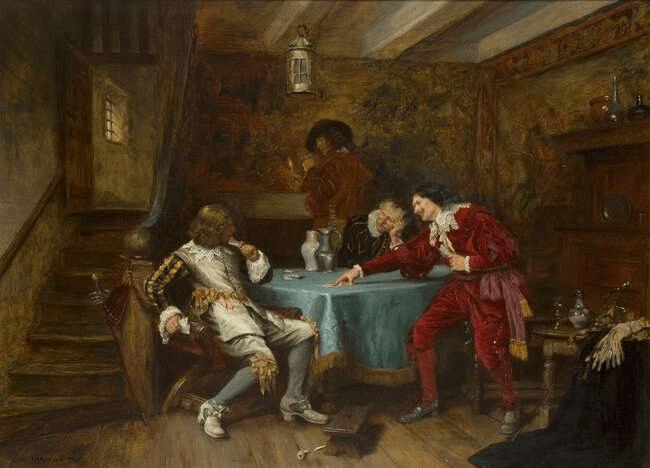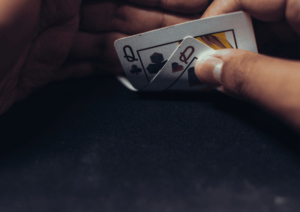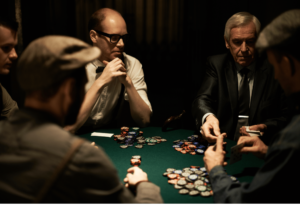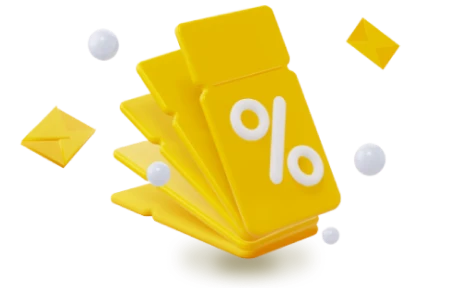How To Play 3 Card Brag – Rules And Strategy
Card games occupy a notable position among traditional British leisure activities. So much that Edward Samuel Taylor cites the famous 18th-century The Spectator publisher, Joseph Addison: “I think it very wonderful to see persons of the best sense passing away a dozen hours together in shuffling and dividing a pack of cards, with no other conversation but what is made up of a few game phrases, or no other ideas but those of black and red spots ranged together in different figures.” It is easy to imagine a group of British gentlemen of the Elizabethan era around a table playing three-card brag. After all, one of the preferred Brits’ card game dates back to the 16th century. It distinguishes itself by relying on strategic prowess and psychological insight, contrasting with games based on chance. This article aims to demystify three-card brag for newcomers, detailing its fundamental rules, strategic considerations, and the skills necessary for proficiency. As we unfold the layers of this game, readers are invited to discover the complexities of a pastime woven into the fabric of British leisure culture.
What Is Exactly a Three-Card Brag?
This three-card game is considered the very first in Great Britain to have been not a game of chance, but a game of skill. A brilliant bluffing skill, to be exact. Preferred by the Brits since the 16th century, a brag is a descendant of a game ‘primero’ o ‘primiera’. The second most important English dramatist after William Shakespeare, Ben Jonson, stated primero to be “the best games at cards for the gallantest company.” (Hargrave 209).
Its origins are obscure—popular in 14th-century Italy, it is also considered primero might have originated in Spain. One way or another, the roots of the game that engrossed all Europe up until recently are in the Mediterranean.
Frank Moss Bennett, A Game of Cards, oil on canvas, 55.5 × 76.5 cm, 1920
From the Elizabethan epoch, brag has made its way into the Commonwealth countries, and, of course, to India, a former colony of the British crown. Now, faras, or teen patti—a variation of three-card brag—is very popular in India and Nepal. But whichever part of the world you find yourself in, the rules of three-card brag and its versions will largely be the same.
How to Play Three-Card Brag
As the name suggests, each player gets 3 cards. A classic 52-card deck, Jokers excluded. The number of those at the table may vary—the maximum number reaches 8, with the minimum number only 2. Rounds last 5–10 minutes. The main goal is to get the strongest three-card brag hand, eliminate all other players until only 2 people are left, and beat the last competitor. You may argue that this description sounds like many other card games. A closer look at the rules, bets, and hands in this version of brag will clarify the picture.
 First Stage
First Stage Everyone around the table (online or offline) places the so-called antes, or else initial bets, in the pot (dealer’s edge). Side bets are also allowed. You may also agree on any special aspects, like using wild cards, or braggers (Ace of diamonds, Jack of clubs, nine of diamonds).
Please note that all players agree on the maximum and the minimum ante before the game starts.
 Second Stage
Second Stage Everyone gets 3 face-down cards. They look at their hands without showing cards to anyone else. If any player wants to play blind, they are entitled to do so. No card exchange is allowed. However, mind that when playing blind, your bet will cost half as much as other players’ who decided to play open. Besides, if you look at your hand before any bet, remember that it becomes open. From this time on, you must bet equal amounts.
Unless a hand is “seen” and won by a prial, the cards are not shuffled in between hands. Instead, the cards are added to the bottom of the stack of cards, and the dealer deals the new hand from the top. (Katz 47)
 Third Stage
Third Stage The player to the left from the dealer chooses whether to call the dealer’s bet, or fold. After the initial bet is opened, all subsequent participants must decide whether to match the bet, raise, or fold, known as stacking. If one decides to keep playing, they need to bet. It is only possible to bet within the limits set at the beginning of the game. But it is not allowed to bet less than the previous player. Otherwise, there’ll be no other choice but to fold.
Unlike poker, the pot is never truly “neat” because subsequent players are required to match the bet of only the previous player and not all previous players. (McNeely 589)
 Fourth Stage
Fourth Stage Betting goes on until only two active players stay. In this case, they can decide on the ‘See’ option to make the opponent lay his hand down first. However, it has its costs. To use it, the previous bet must be doubled. If you hold the winning hand, you should throw in your cards to prove it and say ‘I’ll see you’. In case your hand is worse—concede the pot without revealing it. In this case, it is possible to muck. Assuming players have equal hands, the one who paid to see looses. Lastly, if neither sees the hands of the other, the showdown takes place, and the highest-ranking hand wins.
As players fold, their cards are added to the bottom of the deck. After each game, the deal rotates clockwise, but cards are not reshuffled unless the previous hand was “see a player” and won by a prial. (McNeely 590)
Three-Card Brag Hand Ranks
As mentioned above, people often compare 3-card brag with poker. But they are not the same, and one of their differences is hand ranks. So if you’re transitioning from poker variations to brag, mind that:
- In hands of equal ranks, natural cards beat hands that contain wild cards
- In two hands with braggers it is the highest-ranking bragger hand that wins
- In case opponents hold equally-valued pairs, it is the highest-ranking odd card that wins
- In the odd cards of the same value, the one to win is the high suit. (Scarne 30)
The ranks of the suits:
♠️ — High
♥️
♦️
♣️ — Low
Three-card brag hands are presented in order from the lowest to the highest:
| Hand | Description | Odds |
|---|---|---|
| High Card | Three cards of different values. The highest-ranking card is the one to win in showdown. For instance: A-5-6 beats K-Q-10 | 3:1 |
| Pair | 2 equal cards + 1 unmatched card. In showdown, the higher pair wins | 6:1 |
| Flush | 3 cards of the same suite. In a tie, the flush with the highest-ranking card wins | 20:1 |
| Run/Straight | 3 consecutive cards of different suits | 31:1 |
| Running Flush/On a bike run/Straight Flush | 3 consecutive cards of the same suit. The highest-ranking is 3-2-A, then go the typical A-K-Q, K-Q-J, and so on | 459:1 |
| Prial/Pryle/Three-of-a-Kind | Three cards of a matching rank. | 459:1 |
The Prial is the best hand possible. The highest is 3s (odds 5,524-1), and the rest of Prial hands rank as usual, from three Aces to three 2s.
Three-card brag hand ranks
Three-Card Brag RTP & Payouts
Just like in physical casinos, the online version of 3-card brag against a live dealer and a video-poker version of the game have the RTP reaching up to 98% for the ante bet. It’s almost to 98% for Pair Plus, nearly to 91% for Poker Plus, and a bit more than 96% for the Blind Bay. Don’t neglect studying exact payout numbers when considering the strategy to play.
Ante
Pretty direct payouts for placing an ante bet against the dealer, 1 to 1. If the player’s hand exceeds the dealer’s, they receive an even-money payout to their ante. To qualify, the dealer’s hand must be no less than Queen-high.
| Hands | Payout |
|---|---|
| Run | 1-1 |
| Running Flush | 4-1 |
| Prial | 5-1 |
3-card brag ante payouts
Poker Plus
Poker Plus is a side bet in which the best five-card hand is determined by adding your three cards to the dealer’s three cards. You may put your wager in the poker plus section after you’ve made your ante bet and before any cards are dealt. If your hand qualifies for reward, you will be paid according to the poker plus pay table (see below).The Poker Plus bet might win or lose even if you pass your hand.
| Hands | Payout |
|---|---|
| Prial | 7:1 |
| Run | 10:1 |
| Flush | 15:1 |
| Full House | 20:1 |
| Four-of-a-Kind | 100:1 |
| Running Flush | 200:1 |
| Royal Flush | 1000:1 |
3-card brag Poker Plus payouts
Pair Plus
A risky option as one doesn’t get a bigger chance to win. But sometimes, it’s hard to resist the temptation to maximise the winning potential—especially when ante is too low. Enhanced odds are awarded for hands consisting of two or more cards. It is paid regardless of whether the dealer has a stronger hand or not, but only if the player’s hand contains a pair or more. It is not mandatory to participate in the ante bet to place a pair plus bet. Yet, the majority of players opt to place an ante and a pair plus.
| Hands | Payout |
|---|---|
| Pair | 1:1 |
| Flush | 4:1 |
| Run | 6:1 |
| Running Flush | 30:1 |
| Prial | 40:1 |
3-card brag Pair Plus side bet payouts
Are There Any Ways To Win at 3 Card Brag?
No universal strategy or secret trick would allow everyone to win under any circumstances. Practice, bluffing skills, and clear strategy—combined, they will bring the best result. Three-card brag has quite a basic mechanism—you put down money, and the dealer either takes them or give you more. The only approach would be to match the plus and ante, then play on Q-10 or better. Do not wager more than 1/20th (~5%) of your entire money on any one hand. For example, if you expect to lose £500 throughout your play, begin with £25 ante/£25 pair plus. It’s okay to triple down if the house permits it, even if it pushes you over the 1/20th. You can only triple down on cards that would result in a pair plus, so although your final bet would be 25 ante/55 play/25 pair plus, you’re guaranteed the 25p back or more if you have a stronger hand. If you are a newbie, remember the rules, play for free until you learn everything about the game, memorise the hands, learn to act in particular situations, and then move on to real-money brag.
The Best Sites Where You Can Practice The Game For Free
We mentioned that you should not play real-money 3-card brag until you understand how things really work, learn everything about the pitfalls, try different strategies, and realise which of them works for you personally. This, of course, is possible only if you practice.
Playing with real bets is very, but all adults can join online casinos that allow playing this game for free. We recommend to start at:
- Jackpot Casino
- 888 Casino
- Betway Casino
References
- Bennett, Frank Moss. A Game of Cards. 1920, oil on canvas, private collection. Roseberys, https://www.roseberys.co.uk/a0552-lot-524778, Accessed 9 Apr. 2024.
- Brandreth, Gyles. The Car Player’s Omnibus. London, Willow Books, 1986.
- Card Games: Games for All Ages. Collins Little Books. HarperCollins, Glasgow, 2018.
- Gibson, Walter B. Hoyle’s Encyclopedia of Card Games: Rules of All the Basic Games and Popular Variations. New York, Broadway Books, 1974.
- Hargrave, Catherine Perry. A history of playing cards and a bibliography of cards and gaming. New York, Dover Publications, 1966.
- Katz, Nikki. The Book of Card Games: The Complete Rules to the Classics, Family Favourites, and Forgotten Games. Avon, Massachusetts, AdamsMedia, 2012.
- McNelly, Scott. Ultimate Book of Card Games: The Comprehensive Guide to More Than 350 Games. San Francisco, Chronicle Books, 2009.
- Scarne, John. Scarne’s Encyclopedia of Card Games. New York, Harper & Row, 1983.
- Taylor, Edward Samuel. The History of Playing Cards: With Anecdotes of Their Use in Conjuring, Fortune-telling, and Card-sharping. London, John Camden Hotten, Piccadilly, 1865.















